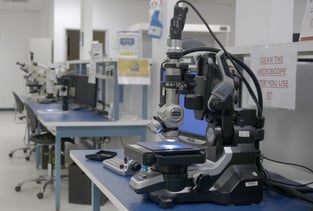February 2022 FAQ: DPA
 Take a look at some of our most frequently asked questions:
Take a look at some of our most frequently asked questions:
What does DPA stand for?
-
- It stands for Destructive Physical Analysis
-
- MIL-STD-150 stated that DPA is a systematic, logical, detailed examination of parts during various stages of physical disassembly, conducted on a sample of completed parts from a given lot, wherein parts are examined for a wide variety of design, workmanship, and processing problems that may not show up during normal screening tests. The purpose of these analyses is to determine those lots of parts, delivered by a vendor, which have anomalies or defects such that they could, at some later date, cause a degradation or catastrophic failure of a system.
-
- External Visual
- Internal Visual using SEM
- Cross Section
- Acoustic Microscopy / Dye Penetrant Testing for PEMs
- Fine and Gross Leak for Hermetic Packages
- Wire Bond Pull / Shear
-
- Typically all Space customers require lot-by-lot DPA for its EEE parts
- DPA is also performed when new product or process is introduced for EEE parts. This provided early warnings of any potential Quality or Reliability issues with the part or process
-
- Almost all EEE parts as defined by NASA. This includes Microcircuits, Discretes (diodes and transistors), Passives (capacitor and resistors), Connectors, Magnetics, PWM amongst others
- Integra provides DPA services for all these parts
-
- MIL-STD-1580 (Most commonly used)
- PEM-INST-001 (most requirements refer to Mil-Std-1580)
- MSFC-STD-3012 (most requirements refer to Mil-Std-1580)
- SSQ 25000 Rev B (Space Station) (most requirements refer to Mil-Std-1580)
- ESCC Basic Specification No. 21001 (European standard)
Read more about our services on our 'DPA & FA' page
Have more questions? Let us know sales_inquiry@integra-tech.com

